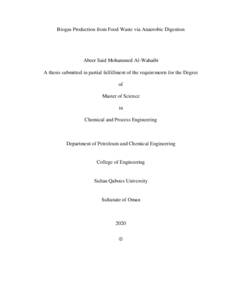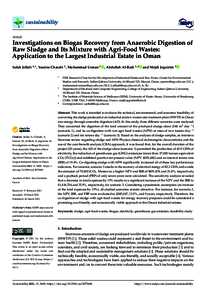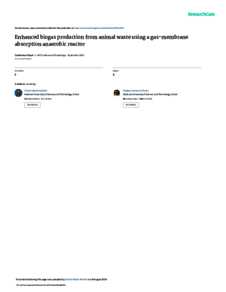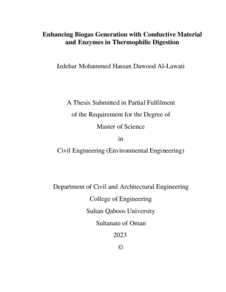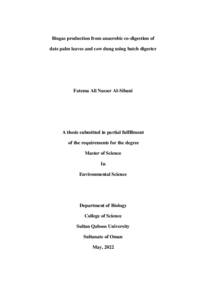وثيقة
Biogas production from food waste via anaerobic digestion.
الناشر
Sultan Qaboos University.
ميلادي
2020
اللغة
الأنجليزية
الملخص الإنجليزي
A large proportion of the required world energy nowadays is covered by fossil fuels. The
consumption of this non-renewable energy source has been increased tremendously over
years. There is a growing interest globally and locally in using different renewable energy
sources. On the other hand, more waste is generated and less of this waste is effectively
handled in terms of recycling, treatment and disposal. The waste generated is mainly
landfilled without sorting. This way of managing solid wastes has both long and short
terms environmental effects. Biogas is one of the most promising renewable energy
sources, which mitigate the increasing amount of wastes.
The major objective of this work was to evaluate the technical and commercial potential
for biogas production from the food waste generated in Fahud camp in Petroleum
Development Oman (PDO). The specific objective of this work was to evaluate the biogas
production potential from different types of food waste and to measure the methane
concentration in the biogas produced from each food waste type at 24 h and at 21
incubation days.
Several analyses were used in this study including; determination of dry matter, invitro
true digestibility, manual gas production, determination of methane gas concentration
using gas chromatography and feed stock nutritional contents evaluation using proximate
analysis.
The results of the dry matter (DM) of the samples used in this research fluctuated between
~20 to 80%. Fruits and vegetables sample showed the highest moisture content (19.6%
DM), followed by the mixed food sample with 25.5% DM. On another hand, the date fruit
sample showed the highest DM percentage (81.7%), followed by the bread waste sample
with 77.2% DM.
The results showed that the total biogas gas produced from the food waste samples used
in this study through anaerobic digestion (in 24 hours) varies between 76 to 421 ml/1 g
DM. The amount is varying based on the composition of the food waste sample. The
highest biogas formation rate resulted from the sample with the highest carbohydrate and
fiber content; due to its high degradability, (i.e. rice waste sample produced 421 ml/1 g
DM, followed by date fruit sample which produced 386 ml / 1 g DM). On another hand,
lower biogas production potential obtained from the samples with the highest protein
content (i.e. fish waste sample produced 76 ml/1 g DM and meat waste sample produced
83 ml/1 g DM).
Furthermore, during the 21 incubation days of anaerobic digestion, a fluctuation in
methane concentration observed in all samples which ranged between 20% and 60%.
Those fluctuations were attributed to the variation in the methanogenic and fatty acids
accumulation levels.
The biogas and the preliminary economic evaluation suggest that, converting food waste
to biogas will add value to both renewable energy and solid waste management sectors.
The technology (if implemented) will potentially add following values to PDO:
▪ Ensures that PDO remains committed to fulfilling its environmental obligations
by reducing energy consumption and seeking new ways/technologies to deal with
the increasing energy demand.
▪ Enhance PDO waste management strategy.
▪ Adapting such initiative will have a positive impact on PDO reputation among
both the industry and the society
المجموعة
URL المصدر
الملخص العربي
نسبة كبيرة من الطاقة العالمية المطلوبة في الوقت الحاضر مغطاة بالوقود الأحفوري. لقد زاد استهلاك هذا المصدر
للطاقة غير المتجددة زيادة هائلة على مدار سنوات. هناك اهتمام متزايد عالميا ومحليا باستخدام مصادر مختلفة للطاقة
المتجددة. من ناحية أخرى، يتم توليد المزيد من النفايات ويتم معالجة القليل من هذه النفايات بشكل فعال من حيث إعادة
التدوير والمعالجة والتخلص. يتم إنشاء النفايات الناتجة بشكل أساسي دون فرز. هذه الطريقة لإدارة النفايات الصلبة
لها آثار بيئية طويلة االأجل وقصيرة الأجل. الغاز الحيوي هو واحد من مصادر الطاقة المتجددة الواعدة، والتي تخفف
من كمية النفايات المتزايدة.
كان الهدف الرئيسي من هذا العمل هو تقييم الإمكانات التقنية والتجارية لإنتاج الغاز الحيوي من مخلفات الطعام الناتجة
في مخيم الفهود في شركة تنمية نفط عمان )PDO). كان الهدف المحدد لهذا العمل هو تقييم إمكانات إنتاج الغاز
الحيوي من أنواع مختلفة من نفايات الطعام وقياس تركيز الميثان في الغاز الحيوي الناتج من كل نوع من نفايات
الطعام في 24 ساعة وفي 21 يوم حضانة.
تم استخدام العديد من التحليلات في هذه الدراسة بما في ذلك: تحديد المادة الجافة، والهضم الحقيقي، والإنتاج اليدوي
للغاز، وتحديد تركيز غاز الميثان باستخدام كروماتوجرافيا الغاز وتقييم محتوى المواد الغذائية لمخزون التغذية
باستخدام التحليل التقريبي.
تقلبت نتائج المادة الجافة )DM )من العينات المستخدمة في هذا البحث بين ~ 20 إلى 80 .٪ أظهرت عينة الخضار
والفواكه أعلى نسبة رطوبة )DM 19.6 ٪)، تليها عينة الأغذية المختلطة بنسبة .٪25.5 من ناحية أخرى، أظهرت
عينة ثمار التمر أعلى نسبة )DM 81.7 ٪)، تليها عينة نفايات الخبز بنسبة 77.2 .٪
أظهرت النتائج أن إجمالي الغاز الحيوي الناتج من عينات فضالت الطعام المستخدمة في هذه الدراسة من خلال الهضم
بنا ء على تكوين عينة نفايات اللاهوائي )خلال 24 ساعة( يتراوح ما بين 76 إلى 421 مل / 1 جم DM. تختلف الكمية
الطعام. ينتج أعلى معدل لتكوين الغاز الحيوي من العينة التي تحتوي على أعلى محتوى من الكربوهيدرات والألياف؛
بسبب قابلية التحلل العالية، )أنتجت عينة نفايات الأرز 421 مل / 1 جم DM، تليها عينة ثمار التمر التي أنتجت 386
مل / 1 جم DM). من ناحية أخرى، انخفاض معدل إنتاج الغاز الحيوي المحتمل التي تم الحصول عليه من العينات
التي تحتوي على أعلى محتوى البروتين )أي عينة من نفايات الأسماك أنتجت 76 مل / 1 جم DM وعينة نفايات
اللحوم أنتجت 83 مل / 1 جم DM). علاوة على ذلك، خلال 21 يوم حضانة من الهضم الالهوائي، لوحظ تذبذب في تركيز الميثان في جميع العينات التي
تراوحت بين 20 ٪ و60 .٪ ويعزى هذا التقلب إلى التباين في مستويات تراكم الأحماض الدهنية والميثانوجينية.
للطاقة غير المتجددة زيادة هائلة على مدار سنوات. هناك اهتمام متزايد عالميا ومحليا باستخدام مصادر مختلفة للطاقة
المتجددة. من ناحية أخرى، يتم توليد المزيد من النفايات ويتم معالجة القليل من هذه النفايات بشكل فعال من حيث إعادة
التدوير والمعالجة والتخلص. يتم إنشاء النفايات الناتجة بشكل أساسي دون فرز. هذه الطريقة لإدارة النفايات الصلبة
لها آثار بيئية طويلة االأجل وقصيرة الأجل. الغاز الحيوي هو واحد من مصادر الطاقة المتجددة الواعدة، والتي تخفف
من كمية النفايات المتزايدة.
كان الهدف الرئيسي من هذا العمل هو تقييم الإمكانات التقنية والتجارية لإنتاج الغاز الحيوي من مخلفات الطعام الناتجة
في مخيم الفهود في شركة تنمية نفط عمان )PDO). كان الهدف المحدد لهذا العمل هو تقييم إمكانات إنتاج الغاز
الحيوي من أنواع مختلفة من نفايات الطعام وقياس تركيز الميثان في الغاز الحيوي الناتج من كل نوع من نفايات
الطعام في 24 ساعة وفي 21 يوم حضانة.
تم استخدام العديد من التحليلات في هذه الدراسة بما في ذلك: تحديد المادة الجافة، والهضم الحقيقي، والإنتاج اليدوي
للغاز، وتحديد تركيز غاز الميثان باستخدام كروماتوجرافيا الغاز وتقييم محتوى المواد الغذائية لمخزون التغذية
باستخدام التحليل التقريبي.
تقلبت نتائج المادة الجافة )DM )من العينات المستخدمة في هذا البحث بين ~ 20 إلى 80 .٪ أظهرت عينة الخضار
والفواكه أعلى نسبة رطوبة )DM 19.6 ٪)، تليها عينة الأغذية المختلطة بنسبة .٪25.5 من ناحية أخرى، أظهرت
عينة ثمار التمر أعلى نسبة )DM 81.7 ٪)، تليها عينة نفايات الخبز بنسبة 77.2 .٪
أظهرت النتائج أن إجمالي الغاز الحيوي الناتج من عينات فضالت الطعام المستخدمة في هذه الدراسة من خلال الهضم
بنا ء على تكوين عينة نفايات اللاهوائي )خلال 24 ساعة( يتراوح ما بين 76 إلى 421 مل / 1 جم DM. تختلف الكمية
الطعام. ينتج أعلى معدل لتكوين الغاز الحيوي من العينة التي تحتوي على أعلى محتوى من الكربوهيدرات والألياف؛
بسبب قابلية التحلل العالية، )أنتجت عينة نفايات الأرز 421 مل / 1 جم DM، تليها عينة ثمار التمر التي أنتجت 386
مل / 1 جم DM). من ناحية أخرى، انخفاض معدل إنتاج الغاز الحيوي المحتمل التي تم الحصول عليه من العينات
التي تحتوي على أعلى محتوى البروتين )أي عينة من نفايات الأسماك أنتجت 76 مل / 1 جم DM وعينة نفايات
اللحوم أنتجت 83 مل / 1 جم DM). علاوة على ذلك، خلال 21 يوم حضانة من الهضم الالهوائي، لوحظ تذبذب في تركيز الميثان في جميع العينات التي
تراوحت بين 20 ٪ و60 .٪ ويعزى هذا التقلب إلى التباين في مستويات تراكم الأحماض الدهنية والميثانوجينية.
قالب العنصر
الرسائل والأطروحات الجامعية

